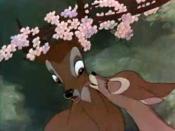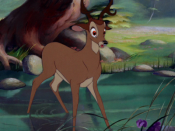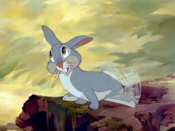Bambi's Misrepresentation of Absent Fathers and Present Mothers Is a mother figure an essential part of a family or is she futile after her aid in the creation of the family? Are father figures more responsible with their parental duties? Although raising a family is a shared effort between two parents, Disney usually praises the father's part in the upbringing of his family, while the mother's part generally goes without acknowledgement. This occurrence is demonstrated in Disney's film, Bambi, where females are solely portrayed as reproducers and are not given further credit for their additional contributions. Thus, Bambi's portrayal of females' helpless behavior and the need for males' protection, aggression and anxiety towards the opposite sex, as well as the unrecognized duties as a mother supports the idea that females' existence is for reproduction purposes and nothing more.
Bambi portrays females in a helpless and vulnerable manner.
As David Payne points out, Faline entraps Bambi into a fierce combat, which forces Bambi to prove his masculinity. After the victory, Faline helplessly follows Bambi in pure submission and adoration. This need for the male's protection supports the idea that the masculine presence is needed for the survival of a female. In return for their protection, females become devoted to the males and thus provide his offsprings. This feeling of obligation to provide future generations for protection is erroneous and immoral. The film rarely portrays moments where the two sexes collaborate, so does that mean that the females do not know how to protect themselves in the absence of a male? Obviously not, because surviving females do exist in the film regardless of the male's presence.
This inaccurate portrayal feeds into the idea that females cannot live without males; when in fact, many independent females live happily and successfully without the presence of men in their lives. This implies that single women who do not find the need to be married are failures in finding the right man and did not fill the role of having children for their husbands. Women have agendas same as men, except women have more barriers against them and with the existence of these false connotations, it makes it very difficult for women to surpass and achieve something. The existence of many happy, successful, and single women in society today proves such implications as invalid With the arrival of spring and the feeling of love in the air, the female animals in the film exhibit an aggressive behavior toward the males. Bambi, Thumper, and Flower all become "victims"ÃÂ of "twitterpation"ÃÂ by their beautiful female counterparts. "The film illustrates the sequential seduction of each teen boy by the wily females of their respective species, whose sole purpose in life seems to be the initiation of the reproductive process"ÃÂ (145). This aggression illustrates a female's only desire to find a mate, and thus create off springs. This one and only acknowledgement between many of a female's duties gives the impression that her reproduction abilities are the only obligation worth mentioning. The over exaggeration of the female's ambitions display their anxiety to mate, when in reality, males are the ones who usually seek out female partners. This in turn, gives the wrong impression to viewers and exemplifies a poor image of women, that women are merely male traps. This also feeds in to the double standards that exist between the men and the women. Just because a female shows aggression towards a male, does not mean she is "ÃÂeasy'. The film shows the males as a victim to the female's flirtations, similar to a witch who casts a spell. This negative connotation embodies a bad reputation of females who may simply be confident to be aggressive toward the opposite sex.
After the creation of the family, the presence of mothers in the movie is scarce. At the conclusion of the movie where the birth scene of Bambi's family is shown, the families of Thumper and Flower, minus the mothers, greet Faline. The death of Bambi's mother in the central point of the movie also shows that a mother's presence is no longer necessary. "[Bambi] point mostly clearly to"æan installation of the patriarchy on the foundation of matricide excuse the mother figure in order to replace her with a kindly-and often more competent-patriarch"à(197). This absence supports the idea that females are primarily used for the purpose of providing future generations, in particular male generations. "The role of women in such society is reproduction of men; the role of the patriarch is to own the means of reproduction"à(144). After a females' duty is fulfilled, their presence is no longer necessary. This idea reinforces the view of women as mere baby makers. The females are used and discarded like a disposable utensil. Therefore, the movie exhibits a stereotypical view of females in society as a lower gender unworthy of the male's status when in reality, males would not be where they are today without the existence of females. Women bring males in to the world, and also raise them to be the future leaders that they are viewed as. Thus, women should get credit for the duty they have fulfilled since the beginning of time.
When mothers are indeed present in the movie, they reinforce the efforts of the fathers. Even though the father figures are often absent in the lives of the young animals in the film, the little efforts and the lessons taught by the fathers are recognized. "Mothers chat and the broods converse in a cross-specific harmony, and the absent fathers retain the voice of family authority"ÃÂ (140). For example, Thumper's mother tells Thumper to recite the lesson taught by his father such as, "If you can't say something nice, don't say anything at all"ÃÂ or "Eating greens is a special treat. It makes long ears and big feet"ÃÂ (Disney). If the father's lessons are so vital, why wasn't the father present to enforce his lessons? Even though this simple lesson could have been that of the mother, Disney made a point to say that it is the lesson of the father, which should be obeyed even with his absence. The gift of bringing life into the world may be a precious gift, but females' importance in the family must be acknowledged.
Even though the father is absent in Bambi's life, the film shows the Great Prince of the forest as the hero who helped Bambi become a "man."ÃÂ This is an unfair depiction because Bambi's mother should be praised for her efforts in raising Bambi. Bambi's mother is responsible for Bambi's imperative lesson on the precautions he must take when entering the meadow as well as what to listen for in order to avoid dangerous hunters. In the process, she sacrifices her life in order to save Bambi's life. Essential lessons such as how to survive is vital to Bambi's life. This lesson taught by Bambi's mother goes without being accredited. Once the mother dies, that is the point where Bambi's father jumps in to the life of his son. The film successfully validates the Great Prince as the hero of making Bambi into a brave and mature stag, and lacks the credit due to Bambi's mother and her sacrificed life. Thus, the passive role of the mothers should be acknowledged and praised because creating and raising a family takes a mother and a father.
Although females are only shown as reproducers and nothing more, mothers are in fact a central part of a family. Mothers nurture their children, help them grow in to a mature adult with or without the help of a father. Thus, women's role is misinterpreted by the lack of mother's praise in Bambi meanwhile the smallest efforts of the males are acknowledged. The shared role of parenting should be publicized because is it only fair and it is also reality-based. The ability to bring life in to the world is a precious gift, but a true mother's work begins with the birth of her child.
Works Cited Bambi. Walt Disney Production.
Haas, Lynda. "Eighty-Six the Mother: Murder, Matricide, and Good Mothers."ÃÂ From Mouse to Mermaid: The Politics of Film, Gender, and Culture. Ed. Elizabeth Bell, Lynda Haas, Laura Sells. Indianapolis: Indianan University Press, 1995. 193-211.
Payne, David. "Bambi."ÃÂ From Mouse to Mermaid: The Politics of Film, Gender, and Culture. Ed. Elizabeth Bell, Lynda Haas, Laura Sells. Indianapolis: Indianan University Press, 1995. 137-147.



